
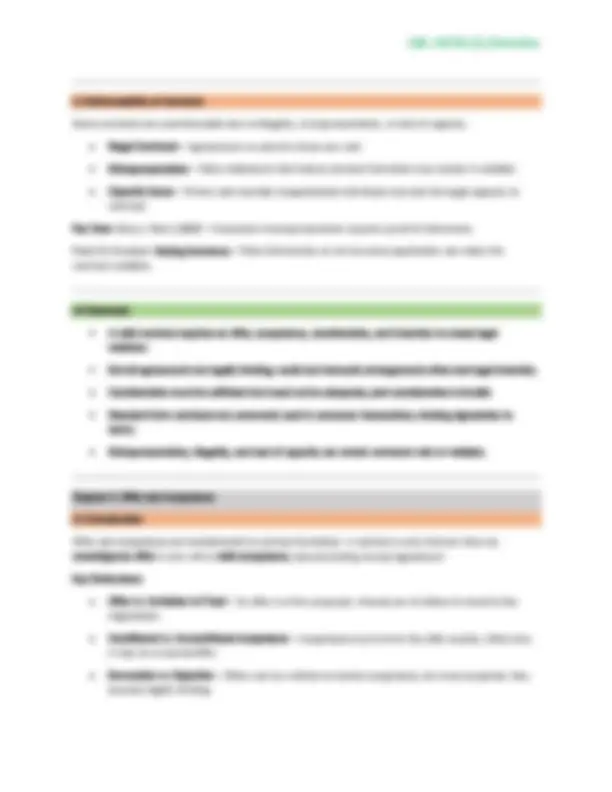
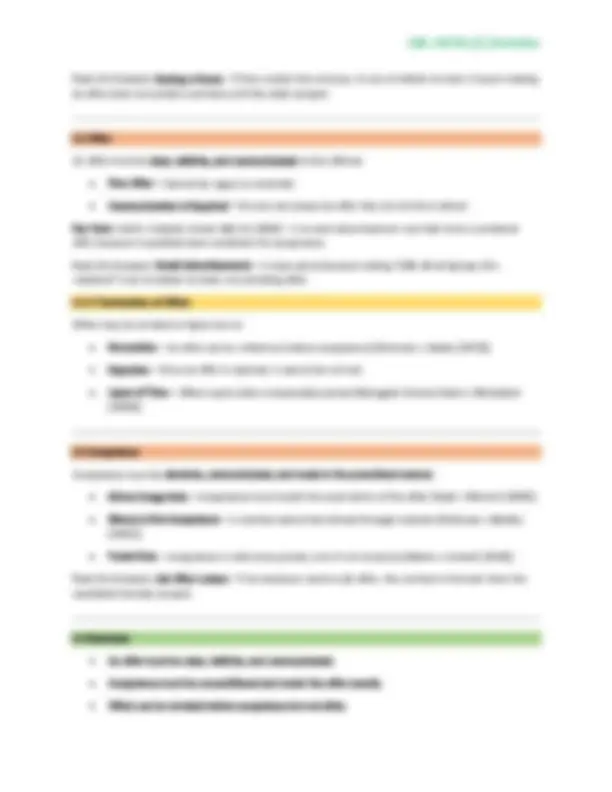
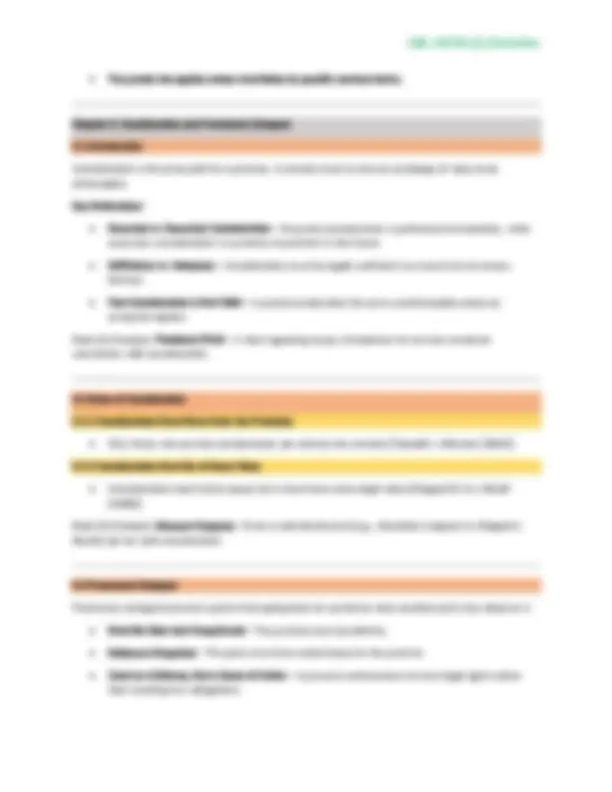

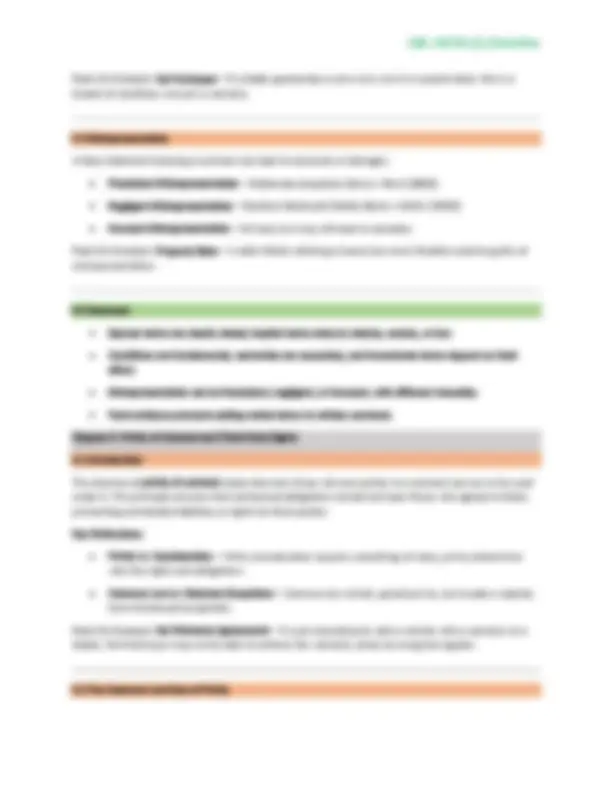
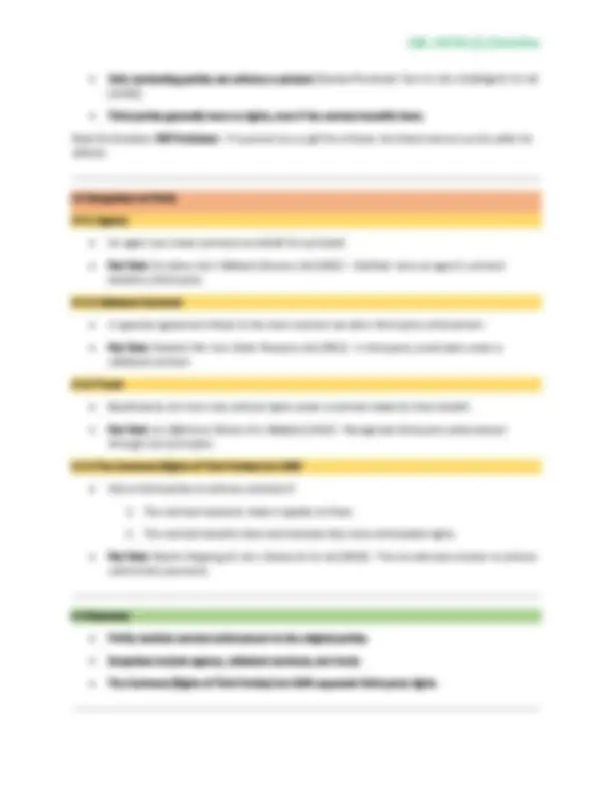

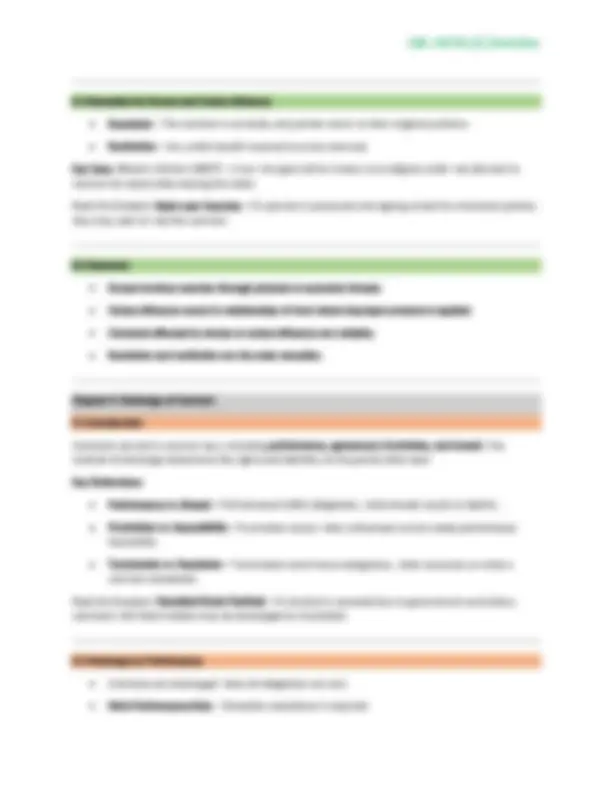
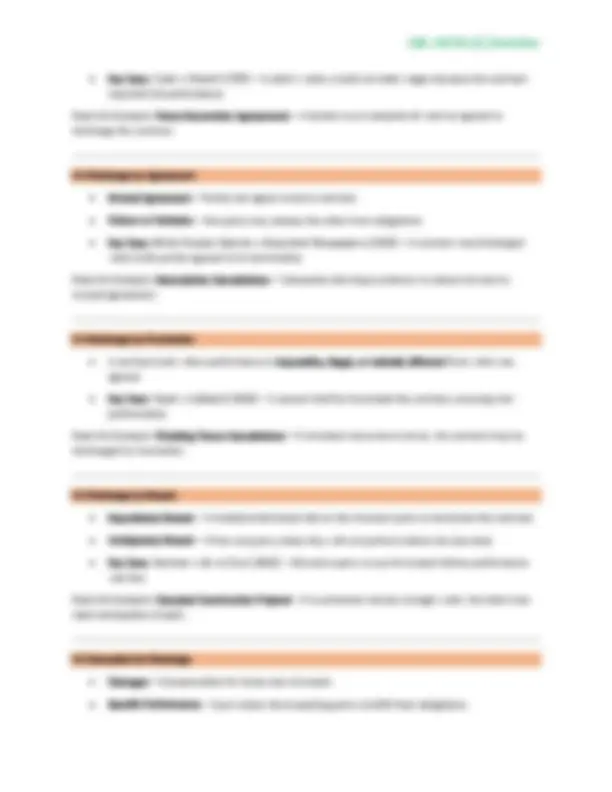

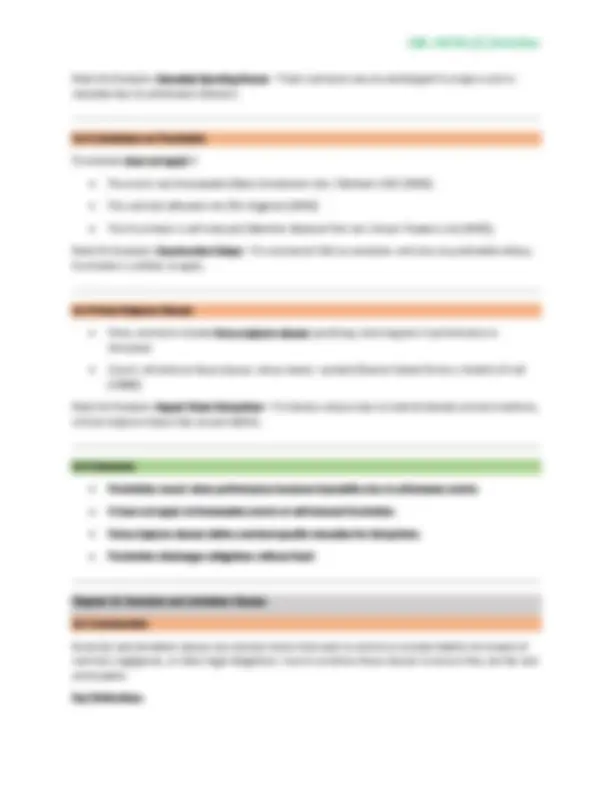
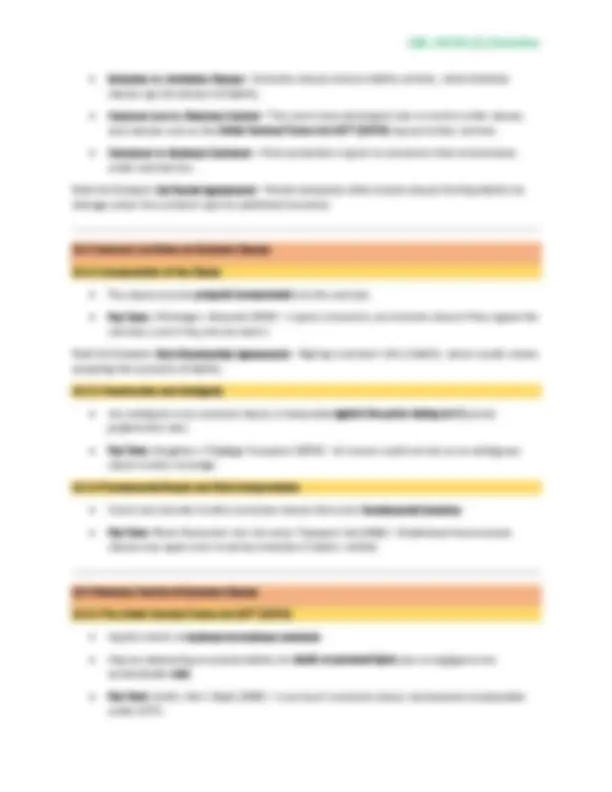
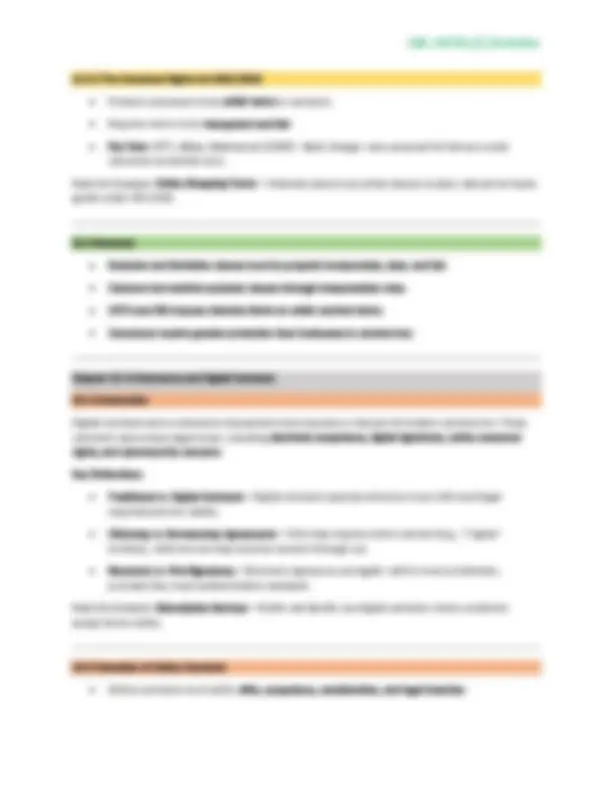
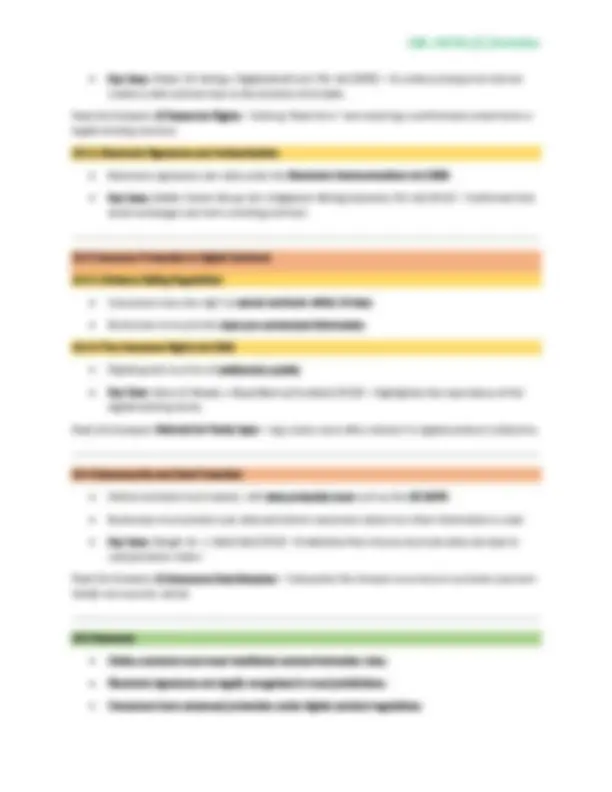



Study with the several resources on Docsity

Earn points by helping other students or get them with a premium plan


Prepare for your exams
Study with the several resources on Docsity

Earn points to download
Earn points by helping other students or get them with a premium plan
Community
Ask the community for help and clear up your study doubts
Discover the best universities in your country according to Docsity users
Free resources
Download our free guides on studying techniques, anxiety management strategies, and thesis advice from Docsity tutors
A contract law overview, covering bilateral vs. unilateral contracts, express vs. implied terms, and offer vs. invitation to treat. It explores contract enforceability, including misrepresentation, illegality, and capacity. The document also examines contractual terms, representations, and breach of contract remedies like damages, specific performance, and rescission. It addresses e-commerce and digital contracts, consumer protection, and exclusion/limitation clauses. Designed to provide a structured understanding of contract law principles and applications, it includes examples and case references. It also covers the Unfair Contract Terms Act 1977 (UCTA) and the Consumer Rights Act 2015 (CRA), which impose limits on unfair terms, protecting consumers.
Typology: Study notes
1 / 23

This page cannot be seen from the preview
Don't miss anything!
















Chapter 1: Introduction to Contract Law 1.1 Introduction Contract law governs agreements between parties, ensuring that legally enforceable promises are honored. Contracts are fundamental to commercial and personal transactions, providing a framework for predictable and fair dealings. Key Distinctions: Bilateral vs. Unilateral Contracts – Bilateral contracts involve mutual obligations, while unilateral contracts require only one party to make a promise. Void vs. Voidable Contracts – A void contract has no legal effect from the outset, while a voidable contract is valid until one party chooses to void it. Contract vs. Tort Law – Contract law deals with agreements, whereas tort law addresses civil wrongs like negligence. Real-Life Example: Buying a Car – When a buyer agrees to purchase a car from a dealership, they enter a bilateral contract, where the buyer promises to pay and the seller promises to deliver the car. 1.2 Essential Elements of a Contract For a contract to be legally enforceable, it must include the following elements: 1.2.1 Offer An offer is a clear statement of willingness to enter into a contract on specific terms. Must be Communicated – An offer must be made known to the other party. Distinguished from an Invitation to Treat – An invitation to treat is merely an invitation to negotiate (e.g., goods displayed in a store). Key Case: Carlill v Carbolic Smoke Ball Co (1893) – An advertisement promising a reward for using a product was ruled to be a unilateral offer because it contained a clear promise. Real-Life Example: Online Shopping – A retailer's website listing a product is an invitation to treat, not an offer. The contract is formed when the seller accepts the buyer’s order. 1.2.2 Acceptance Acceptance must be unqualified and communicated to the offeror. Mirror Image Rule – Acceptance must match the terms of the offer exactly. Postal Rule – Acceptance is effective when posted, even if the offeror has not yet received it.
Key Case: Adams v Lindsell (1818) – Established the postal rule, confirming that acceptance is complete once the letter is sent. Real-Life Example: Job Offers – If an employer offers a job and the candidate accepts it without modifications, a binding contract is formed. 1.2.3 Consideration Consideration is something of value exchanged between parties. Must be Sufficient but Need Not Be Adequate – Courts do not assess fairness. Past Consideration Is Not Valid – Consideration must be given in exchange for a promise. Key Case: Chappell & Co Ltd v Nestlé (1960) – Chocolate wrappers were held to be valid consideration as part of a promotional contract. Real-Life Example: Gift vs. Contract – A promise to give someone a car as a gift is not enforceable without consideration (unless under a deed). 1.2.4 Intention to Create Legal Relations There must be an intention to be legally bound. Presumed in Commercial Agreements. Not Presumed in Social or Domestic Agreements, unless evidence suggests otherwise. Key Case: Balfour v Balfour (1919) – A husband's promise to pay his wife an allowance was ruled non- binding due to lack of intention. Real-Life Example: Business Partnerships – Agreements between business partners typically have legal intention and are enforceable. 1.3 Types of Contracts Contracts vary in form and function, including: Express vs. Implied Contracts – Express contracts have stated terms, while implied contracts arise from conduct. Executed vs. Executory Contracts – An executed contract is fully performed, whereas an executory contract has outstanding obligations. Standard Form Contracts – Pre-drafted contracts commonly used in consumer transactions (e.g., mobile phone contracts). Key Case: L’Estrange v F Graucob Ltd (1934) – A party is bound by a contract they sign, even if they do not read its terms. Real-Life Example: Gym Memberships – Standard form contracts are used, and signing means agreeing to all terms, even if not read.
Real-Life Example: Buying a House – When a seller lists a house, it is an invitation to treat. A buyer making an offer does not create a contract until the seller accepts. 2.2 Offer An offer must be clear, definite, and communicated to the offeree. Firm Offer – Cannot be vague or uncertain. Communication is Required – No one can accept an offer they do not know about. Key Case: Carlill v Carbolic Smoke Ball Co (1893) – A reward advertisement was held to be a unilateral offer because it specified clear conditions for acceptance. Real-Life Example: Retail Advertisements – A store advertisement stating "50% off all laptops this weekend" is an invitation to treat, not a binding offer. 2.2.1 Termination of Offers Offers may be revoked or lapse due to: Revocation – An offer can be withdrawn before acceptance ( Dickinson v Dodds (1876) ). Rejection – Once an offer is rejected, it cannot be revived. Lapse of Time – Offers expire after a reasonable period ( Ramsgate Victoria Hotel v Montefiore (1866) ). 2.3 Acceptance Acceptance must be absolute, communicated, and made in the prescribed manner. Mirror Image Rule – Acceptance must match the exact terms of the offer ( Hyde v Wrench (1840) ). Silence is Not Acceptance – A contract cannot be formed through inaction ( Felthouse v Bindley (1862) ). Postal Rule – Acceptance is valid once posted, even if not received ( Adams v Lindsell (1818) ). Real-Life Example: Job Offer Letters – If an employer sends a job offer, the contract is formed when the candidate formally accepts. 2.4 Summary An offer must be clear, definite, and communicated. Acceptance must be unconditional and match the offer exactly. Offers can be revoked before acceptance but not after.
The postal rule applies unless overridden by specific contract terms. Chapter 3: Consideration and Promissory Estoppel 3.1 Introduction Consideration is the price paid for a promise. A contract must involve an exchange of value to be enforceable. Key Distinctions: Executed vs. Executory Consideration – Executed consideration is performed immediately, while executory consideration is a promise to perform in the future. Sufficiency vs. Adequacy – Consideration must be legally sufficient, but courts do not assess fairness. Past Consideration is Not Valid – A promise made after the act is unenforceable unless an exception applies. Real-Life Example: Freelance Work – A client agreeing to pay a freelancer for services rendered constitutes valid consideration. 3.2 Rules of Consideration 3.2.1 Consideration Must Move from the Promisee Only those who provide consideration can enforce the contract ( Tweddle v Atkinson (1861) ). 3.2.2 Consideration Must Be of Some Value Consideration need not be equal, but it must have some legal value ( Chappell & Co v Nestlé (1960) ). Real-Life Example: Discount Coupons – Even a nominal amount (e.g., chocolate wrappers in Chappell v Nestlé ) can be valid consideration. 3.3 Promissory Estoppel Promissory estoppel prevents a party from going back on a promise when another party has relied on it. Must Be Clear and Unequivocal – The promise must be definite. Reliance is Required – The party must have acted based on the promise. Used as a Defense, Not a Cause of Action – It prevents enforcement of strict legal rights rather than creating new obligations.
Separation Agreements – Courts are more likely to enforce agreements between separating spouses ( Merritt v Merritt (1970) ). Real-Life Example: Shared Expenses in Cohabitation – If two partners share mortgage payments and one fails to contribute, the court may enforce an agreement based on financial reliance. 4.3 Commercial Agreements Business agreements are presumed to have legal intent. Parties seeking to avoid enforceability must provide clear wording (e.g., “this agreement is not legally binding”). Key Case: Edwards v Skyways Ltd (1964) – A promise to pay a redundancy bonus was enforceable as it was a business agreement. 4.3.1 Advertisements and Mere Puffery Mere sales talk is not legally binding ( Carlill v Carbolic Smoke Ball Co (1893) showed an exception where specific promises were made). Collective Bargaining Agreements – Agreements between trade unions and employers are typically not legally enforceable. Real-Life Example: Company Promotions – A restaurant claiming "best pizza in town" is making a puffery statement, not a contractual promise. 4.4 Summary Social and domestic agreements are presumed not to have legal intent. Commercial agreements are presumed to be legally binding. Presumptions can be rebutted with clear evidence. Mere puffery in advertisements is not legally binding. Chapter 5: Contractual Terms and Representations 5.1 Introduction Contract terms define the rights and obligations of parties. A distinction is made between terms (binding obligations) and representations (statements made before contract formation). Key Distinctions: Express vs. Implied Terms – Express terms are clearly stated, while implied terms are inserted by law or custom.
Conditions vs. Warranties vs. Innominate Terms – Conditions are fundamental, warranties are less critical, and innominate terms depend on their impact. Terms vs. Representations – Misstatements can either be contractual terms or pre-contractual representations. Real-Life Example: Buying a Phone – If a retailer claims a phone has a 12-hour battery life but it lasts only 6 hours, this could be a misrepresentation or a breach of contract. 5.2 Express and Implied Terms 5.2.1 Express Terms Clearly stated in the contract (written or oral). Parol Evidence Rule – Written contracts cannot be altered by prior verbal agreements ( L’Estrange v Graucob (1934) ). Real-Life Example: Signed Contracts – If you sign a gym membership agreement, you are bound by all terms, even if you did not read them. 5.2.2 Implied Terms By Statute – The Sale of Goods Act 1979 implies terms about product quality. By Custom – Industry norms may imply terms. By the Courts – Courts may imply terms to give business efficacy to an agreement ( The Moorcock (1889) ). Real-Life Example: Hotel Bookings – A hotel implicitly promises to provide a safe and clean environment. 5.3 Classification of Contractual Terms 5.3.1 Conditions Fundamental to the contract; breach allows termination. Poussard v Spiers (1876) – A singer’s failure to perform was a breach of condition. 5.3.2 Warranties Less important terms; breach allows for damages but not termination. Bettini v Gye (1876) – A singer’s failure to attend rehearsals was a breach of warranty. 5.3.3 Innominate Terms Assessed based on the severity of breach. Hong Kong Fir Shipping v Kawasaki (1962) – A term’s classification depends on its effect.
Only contracting parties can enforce a contract ( Dunlop Pneumatic Tyre Co Ltd v Selfridge & Co Ltd (1915) ). Third parties generally have no rights, even if the contract benefits them. Real-Life Example: Gift Purchases – If a person buys a gift for a friend, the friend cannot sue the seller for defects. 6.3 Exceptions to Privity 6.3.1 Agency An agent can create contracts on behalf of a principal. Key Case: Scruttons Ltd v Midland Silicones Ltd (1962) – Clarified when an agent’s contract benefits a third party. 6.3.2 Collateral Contracts A separate agreement linked to the main contract can allow third-party enforcement. Key Case: Shanklin Pier Ltd v Detel Products Ltd (1951) – A third party could claim under a collateral contract. 6.3.3 Trusts Beneficiaries of a trust may enforce rights under a contract made for their benefit. Key Case: Les Affreteurs Réunis SA v Walford (1919) – Recognized third-party enforcement through trust principles. 6.3.4 The Contracts (Rights of Third Parties) Act 1999 Allows third parties to enforce contracts if:
Chapter 7: Mistake and Misrepresentation 7.1 Introduction A contract may be void or voidable due to a fundamental mistake or misrepresentation. Mistake occurs when both parties misunderstand an essential fact, while misrepresentation involves one party inducing another into a contract through false statements. Key Distinctions: Common Mistake vs. Mutual Mistake vs. Unilateral Mistake – Common mistakes affect both parties; mutual mistakes involve misunderstanding different terms; unilateral mistakes occur when one party is mistaken, and the other knows. Misrepresentation vs. Breach of Contract – Misrepresentation deals with false pre-contractual statements, while breach of contract involves failure to fulfill agreed terms. Real-Life Example: Property Sales – If a seller falsely claims that a house is free from structural issues, this could amount to misrepresentation. 7.2 Types of Mistake 7.2.1 Common Mistake Both parties share the same incorrect assumption about a fundamental fact. Key Case: Bell v Lever Bros Ltd (1932) – A mistake must be fundamental to void a contract. 7.2.2 Mutual Mistake Both parties misunderstand different aspects of the contract. Key Case: Raffles v Wichelhaus (1864) – A contract was void due to confusion over which ship carried the goods. 7.2.3 Unilateral Mistake One party is mistaken, and the other knows but does not correct the error. Key Case: Hartog v Colin & Shields (1939) – A buyer could not enforce a mistaken pricing term they knew was an error. Real-Life Example: E-Commerce Pricing Errors – If an online retailer mistakenly lists a high-value item for a fraction of its cost, they may be able to void the sale under unilateral mistake principles. 7.3 Types of Misrepresentation 7.3.1 Fraudulent Misrepresentation A false statement made knowingly, recklessly, or without belief in its truth.
Duress vs. Undue Influence – Duress involves direct threats, whereas undue influence arises from pressure due to a relationship of trust. Physical vs. Economic Duress – Physical duress involves threats of violence, while economic duress involves illegitimate financial pressure. Presumed vs. Actual Undue Influence – Some relationships automatically raise a presumption of undue influence. Real-Life Example: Signing a Loan Agreement Under Threat – If someone is threatened into signing a loan contract, the agreement may be voidable. 8.2 Duress 8.2.1 Physical Duress A contract is voidable if entered into under threats of violence. Key Case: Barton v Armstrong (1976) – A contract signed under threat of death was voidable for duress. 8.2.2 Economic Duress Occurs when a party is forced into a contract due to illegitimate economic pressure. Key Case: The Atlantic Baron (1979) – Economic threats to withhold delivery of a ship led to a voidable contract. Real-Life Example: Business Extortion – A supplier refusing to deliver goods unless the buyer pays an extra fee beyond the agreed price. 8.3 Undue Influence 8.3.1 Actual Undue Influence Where one party directly pressures another into an agreement. Key Case: Williams v Bayley (1866) – A son was forced to mortgage property due to parental coercion. 8.3.2 Presumed Undue Influence Arises in relationships of trust and confidence, such as doctor-patient or solicitor-client. Key Case: Royal Bank of Scotland v Etridge (No 2) (2001) – Established that lenders must ensure borrowers receive independent legal advice in undue influence cases. Real-Life Example: Elderly Parents and Financial Transactions – If an elderly parent is pressured by a child to transfer property, undue influence may be claimed.
8.4 Remedies for Duress and Undue Influence Rescission – The contract is set aside, and parties return to their original positions. Restitution – Any unfair benefit received must be returned. Key Case: Allcard v Skinner (1887) – A nun who gave all her money to a religious order was allowed to recover her assets after leaving the order. Real-Life Example: Bank Loan Coercion – If a person is pressured into signing a loan for a business partner, they may seek to void the contract. 8.5 Summary Duress involves coercion through physical or economic threats. Undue influence occurs in relationships of trust where improper pressure is applied. Contracts affected by duress or undue influence are voidable. Rescission and restitution are the main remedies. Chapter 9: Discharge of Contract 9.1 Introduction Contracts can end in several ways, including performance, agreement, frustration, and breach. The method of discharge determines the rights and liabilities of the parties afterward. Key Distinctions: Performance vs. Breach – Performance fulfills obligations, while breach results in liability. Frustration vs. Impossibility – Frustration occurs when unforeseen events make performance impossible. Termination vs. Rescission – Termination ends future obligations, while rescission unwinds a contract completely. Real-Life Example: Cancelled Music Festivals – If a festival is canceled due to government restrictions, contracts with ticket holders may be discharged by frustration. 9.2 Discharge by Performance Contracts are discharged when all obligations are met. Strict Performance Rule – Complete compliance is required.
Restitution – Prevents unjust enrichment if a party benefits unfairly. Key Case: Photo Production Ltd v Securicor Transport Ltd (1980) – Established when a breach allows contract termination. Real-Life Example: Breach of Employment Contracts – If an employer wrongfully dismisses an employee, they may seek damages. 9.7 Summary Contracts can be discharged by performance, agreement, frustration, or breach. Frustration applies when unforeseen events make performance impossible. Repudiatory and anticipatory breaches allow contract termination. Remedies include damages, specific performance, and restitution. Chapter 10: Remedies for Breach of Contract 10.1 Introduction When a contract is breached, the injured party may seek legal remedies to enforce the contract or compensate for losses. Remedies can be compensatory (damages), equitable (specific performance), or restitutionary (unjust enrichment). Key Distinctions: Legal vs. Equitable Remedies – Legal remedies typically involve monetary compensation, whereas equitable remedies involve court orders enforcing or modifying obligations. Expectation vs. Reliance Damages – Expectation damages aim to put the claimant in the position they would have been in had the contract been performed; reliance damages compensate for expenses incurred in reliance on the contract. Liquidated vs. Unliquidated Damages – Liquidated damages are pre-agreed sums in the contract, while unliquidated damages are determined by the court. Real-Life Example: Hotel Overbooking Compensation – If a hotel cancels a prepaid booking, the customer may claim damages for extra costs incurred in finding alternative accommodation. 10.2 Types of Damages 10.2.1 Compensatory Damages Aim to restore the claimant to the position they would have been in if the contract had been fulfilled. Key Case: Robinson v Harman (1848) – Established the principle of expectation damages.
Real-Life Example: Missed Business Opportunity – If a supplier fails to deliver critical components on time, the buyer may claim lost profits as damages. 10.2.2 Reliance Damages Compensate for wasted costs incurred due to reliance on the contract. Key Case: Anglia Television Ltd v Reed (1972) – A TV company recovered pre-production costs after an actor breached his contract. 10.2.3 Nominal Damages Awarded where a breach occurs but no actual loss is suffered. Key Case: Staniforth v Lyall (1830) – Nominal damages were awarded since the claimant had no measurable loss. Real-Life Example: Symbolic Legal Victory – A company suing for breach of contract may be awarded a small sum if no financial loss occurred but a legal principle was upheld. 10.2.4 Liquidated and Unliquidated Damages Liquidated damages are pre-agreed sums enforceable unless deemed a penalty. Unliquidated damages are assessed by the court. Key Case: Dunlop Pneumatic Tyre Co Ltd v New Garage & Motor Co Ltd (1915) – Courts will enforce liquidated damages if they are a genuine pre-estimate of loss. 10.3 Equitable Remedies 10.3.1 Specific Performance Orders the breaching party to fulfill contractual obligations. Key Case: Beswick v Beswick (1968) – A widow was granted specific performance to enforce a contract for payments to her after her husband’s death. Real-Life Example: Real Estate Contracts – Courts often enforce specific performance in property sales, as monetary damages may not be adequate. 10.3.2 Injunctions Prevent a party from acting contrary to contractual obligations. Key Case: Warner Bros v Nelson (1937) – An injunction prevented actress Bette Davis from working for a competitor in breach of contract. 10.3.3 Rescission Cancels the contract and restores parties to their pre-contract position.
Real-Life Example: Cancelled Sporting Events – Ticket contracts may be discharged if a major event is canceled due to unforeseen disasters. 11.3 Limitations on Frustration Frustration does not apply if: The event was foreseeable ( Davis Contractors Ltd v Fareham UDC (1956) ). The contract allocates risk ( The Eugenia (1964) ). The frustration is self-induced ( Maritime National Fish Ltd v Ocean Trawlers Ltd (1935) ). Real-Life Example: Construction Delays – If a contractor fails to complete work due to predictable delays, frustration is unlikely to apply. 11.4 Force Majeure Clauses Many contracts include force majeure clauses specifying what happens if performance is disrupted. Courts will enforce these clauses where clearly worded ( Channel Island Ferries v Sealink UK Ltd (1988) ). Real-Life Example: Supply Chain Disruptions – If a factory closure due to natural disaster prevents delivery, a force majeure clause may excuse liability. 11.5 Summary Frustration occurs when performance becomes impossible due to unforeseen events. It does not apply to foreseeable events or self-induced frustration. Force majeure clauses define contract-specific remedies for disruptions. Frustration discharges obligations without fault. Chapter 12: Exclusion and Limitation Clauses 12.1 Introduction Exclusion and limitation clauses are contract terms that seek to restrict or exclude liability for breach of contract, negligence, or other legal obligations. Courts scrutinize these clauses to ensure they are fair and enforceable. Key Distinctions:
Exclusion vs. Limitation Clauses – Exclusion clauses remove liability entirely, while limitation clauses cap the amount of liability. Common Law vs. Statutory Control – The courts have developed rules to restrict unfair clauses, and statutes such as the Unfair Contract Terms Act 1977 (UCTA) impose further controls. Consumer vs. Business Contracts – More protection is given to consumers than to businesses under contract law. Real-Life Example: Car Rental Agreements – Rental companies often include clauses limiting liability for damage unless the customer opts for additional insurance. 12.2 Common Law Rules on Exclusion Clauses 12.2.1 Incorporation of the Clause The clause must be properly incorporated into the contract. Key Case: L’Estrange v Graucob (1934) – A party is bound by an exclusion clause if they signed the contract, even if they did not read it. Real-Life Example: Gym Membership Agreements – Signing a contract with a liability waiver usually means accepting the exclusion of liability. 12.2.2 Construction and Ambiguity Any ambiguity in an exclusion clause is interpreted against the party relying on it ( contra proferentem rule ). Key Case: Houghton v Trafalgar Insurance (1954) – An insurer could not rely on an ambiguous clause to deny coverage. 12.2.3 Fundamental Breach and Strict Interpretation Courts are reluctant to allow exclusion clauses that cover fundamental breaches. Key Case: Photo Production Ltd v Securicor Transport Ltd (1980) – Established that exclusion clauses may apply even to serious breaches if clearly worded. 12.3 Statutory Control of Exclusion Clauses 12.3.1 The Unfair Contract Terms Act 1977 (UCTA) Applies mainly to business-to-business contracts. Clauses attempting to exclude liability for death or personal injury due to negligence are automatically void. Key Case: Smith v Eric S Bush (1990) – A surveyor’s exclusion clause was deemed unreasonable under UCTA.